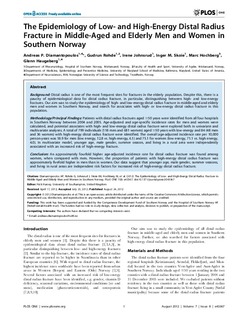| dc.contributor.author | Diamantopoulos, Andreas P. | |
| dc.contributor.author | Rohde, Gudrun | |
| dc.contributor.author | Johnsrud, Irene | |
| dc.contributor.author | Skoie, Inger M. | |
| dc.contributor.author | Hochberg, Marc | |
| dc.contributor.author | Haugeberg, Glenn | |
| dc.date.accessioned | 2012-09-07T12:47:32Z | |
| dc.date.available | 2012-09-07T12:47:32Z | |
| dc.date.issued | 2012 | |
| dc.identifier.citation | Diamantopoulos, A.P., Rohde, G., Johnsrud, I., Skoie, I.M., Hochberg, M., & Haugeberg, G. (2012). The epidemiology of low- and high-energy distal radius fracture in middle-aged and elderly men and women in southern norway. PLoS One, 7(8), e43367. doi: 10.1371/journal.pone.0043367 | no_NO |
| dc.identifier.issn | 1932-6203 | |
| dc.identifier.uri | http://hdl.handle.net/11250/138692 | |
| dc.description | Published version of an article in the journal: PLoS One. Also available from the publisher: http://dx.doi.org/10.1371/journal.pone.0043367 | no_NO |
| dc.description.abstract | BACKGROUND: Distal radius is one of the most frequent sites for fractures in the elderly population. Despite this, there is a paucity of epidemiological data for distal radius fracture, in particular, distinguishing between high- and low-energy fractures. Our aim was to study the epidemiology of high- and low-energy distal radius fracture in middle-aged and elderly men and women in Southern Norway, and search for associates with high- or low-energy distal radius fracture in this population. METHODOLOGY/PRINCIPAL FINDINGS: Patients with distal radius fractures aged >/=50 years were identified from all four hospitals in Southern Norway between 2004 and 2005. Age-adjusted and age-specific incidence rates for men and women were calculated, and potential associates with high- and low-energy distal radius fracture were explored both in univariate and multivariate analyses. A total of 799 individuals (118 men and 681 women) aged >/=50 years with low-energy and 84 (48 men and 36 women) with high-energy distal radius fracture were identified. The overall age-adjusted incidence rate per 10,000 person-years was 18.9 for men (low energy, 12.8 vs. high-energy, 6.1) and 75.1 for women (low energy, 71.1 vs. high energy, 4.0). In multivariate model, younger age, male gender, summer season, and living in a rural area were independently associated with an increased risk of high-energy fracture. CONCLUSION: An approximately fourfold higher age-adjusted incidence rate for distal radius fracture was found among women, when compared with men. However, the proportion of patients with high-energy distal radius fracture was approximately fivefold higher in men than in women. Our data suggest that younger age, male gender, summer seasons, and living in rural areas are independent risk factors for increased risk of high-energy distal radius fracture. | no_NO |
| dc.language.iso | eng | no_NO |
| dc.publisher | PLoS | no_NO |
| dc.title | The epidemiology of low- and high-energy distal radius fracture in middle-aged and elderly men and women in Southern Norway | no_NO |
| dc.type | Journal article | no_NO |
| dc.type | Peer reviewed | no_NO |
| dc.subject.nsi | VDP::Medical disciplines: 700::Clinical medical disciplines: 750::Rheumatology: 759 | no_NO |
| dc.source.pagenumber | 8 | no_NO |
| dc.source.volume | 7 | no_NO |
| dc.source.journal | PLoS One | no_NO |
